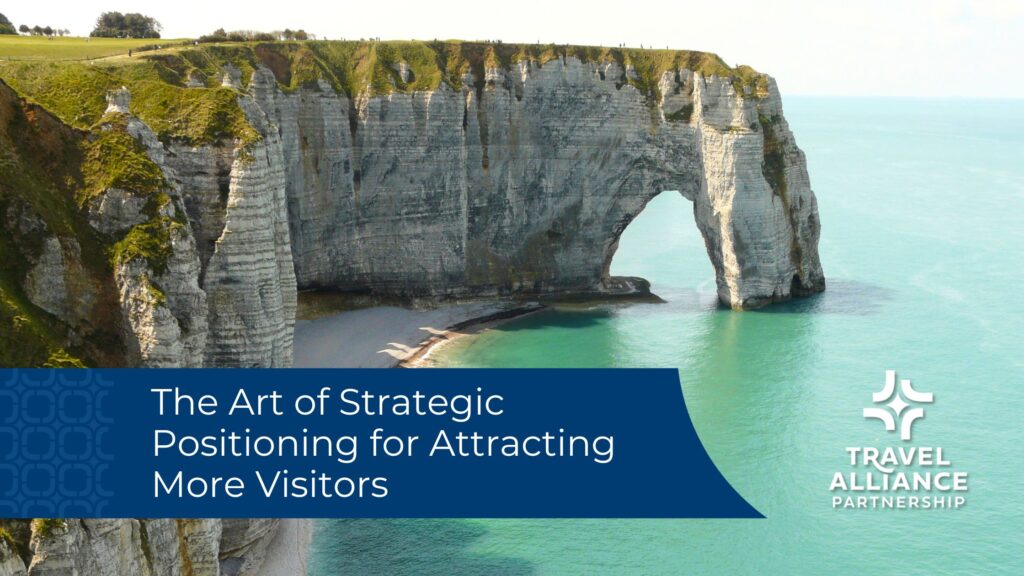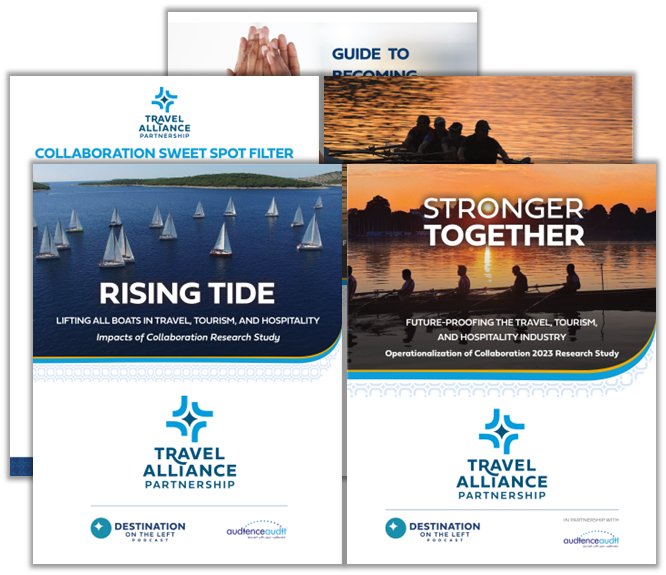The Art of Strategic Positioning for Attracting More Visitors
I often hear people talk about writing with the premise that you start by “staring at a blank screen,” but a blank screen is rarely where we start when drafting content for clients. That’s because we start with strategy and positioning, giving us a framework to jumpstart our creative engines. Strategic models help organize data, focus thinking, take out the guesswork and differentiate a brand from its competitors. These models also help when presenting the strategy to others. In TAP’s strategic planning process, we work on developing insights from data and establishing strategic positioning that inform the entire plan.

Establishing Strategic Positioning
The first part of our strategic planning process is research and discovery. During this time, we interview organization leadership, hold a team visit in the case of destinations and attractions, conduct secondary research and host a creative strategy workshop with leadership and stakeholders.
We first started working with tour operator Old Sod Travel on their digital advertising in 2021 as people started returning to travel. During the research and discovery phase, we learned why travelers would want to use their service, what differentiates them from competitors, and what luxury travelers are looking for. The results of this research formed the strategic positioning for the brand:
- Transformational Experiences. Relaying the emotions of travel and connect with the aspiration of planning a trip of a lifetime.
- Authentic Luxury Tours. Guests wake up knowing they’re someplace special and spend the day among the new and different. This is about having cultural immersion within a destination, and soaking in high-end experiences.
- Hand in Hand Planning. Tours are fully customized for each trip, there are no pre-set itineraries. The travel consultants at Old Sod tailor each itinerary to the travelers wants and interests.
- Once, Again. Taking more than one trip of a lifetime. Crossing off multiple bucket list items with the singular experiences Old Sod provides to many destinations.
In addition to positioning themes, every strategy we work on contains strategic insights. Both the insights and strategic positioning form the basis for the key messages and inform the messaging across all channels.
What are Strategic Insights?
According to Mercer Island Group, a top agency search firm that works with some of the world’s largest brands, a strategic insight is “a penetrating truth that elevates strategy, enabling highly differentiated tactics.”
Defining a strategic insight starts with collecting research and data points that fit into several focus areas. We pull all that knowledge together through evaluation and analysis to come up with a strategic insight for each focus area. These focus areas typically are brand, consumer, and competition. We’ll sometimes bring in community for a focus area too, as it fits so well with destination marketing.
Using Your Data
Once the data is collected, we look at it to draw conclusions and comparisons about what is there. The data is telling a story, and we want to look at what’s on the page and make sense of it in terms of the focus area it’s in. As we pull these interpretations out of the data, we distill all of the research and work into clear, strategy-driving statements that will lay the foundation for messaging, approach and tactics.
The Overall Strategic Positioning
Creating the focus area insights involves going beyond the data on the page, beyond the comparisons and coming to the big-picture truth for each focus area that makes the most sense for your organization. In defining the strategic positioning, we look for the point where the insights from the 3-5 focus areas intersect. It is a compelling statement rather than a simple summary. It’s all at once an “ah-ha!” and an “oh! of course!”
Once we reach the strategic positioning, it informs the messaging, tactics, approach and much of the rest of the strategy. It is a piece of the strategy that we come back to again and again to keep the marketing pointed in the right direction (the goals).
A Strategic Positioning Example
This example comes from our work with Cayuga County, NY on the Harriet Tubman campaign. These brief summaries show a glimpse into the research completed and findings of the competition, product and consumer analyses. Then, you’ll see the corresponding insights and overall positioning statement.
Focus Area: Competition
Three other destinations can claim Harriet Tubman among their residents during her life: Dorchester, Maryland; Philadelphia, Pennsylvania; St. Catharine’s, Ontario. Of the three, Maryland has focused most heavily on Tubman in their tourism marketing with both Visit Dorchester and Visit Maryland promoting her prominently on their websites. However, the communities don’t seem to embrace Harriet Tubman and the Underground Railroad story as most of the focus is on the history.
Competition insight: Cayuga County has the opportunity to tell her story differently by embracing her spirit.
Focus Area: Product
Auburn is surrounded by places known for their part in the equal rights and women’s equal rights movements. Auburn is full of places Harriet visited and frequented along with tributes and sculptures. Unlike anywhere else, Auburn is Harriet’s final resting place, her chosen home. It’s where she brought her family, married her husband, owned her own home and land, and spent her time in freedom. Auburn is where she lived as an equal with her neighbors and found community.
Product insight: Auburn has historically been a leading community in equal rights and still is to this day.
Focus Area: Consumer
Social justice travel is an upcoming tourism trend. Socially conscious people’s demographics and travel patterns have not been widely studied. However, social justice tours and tour operators have started to pop up. Articles about how to travel in a socially conscious or equitable way are being written. These travelers’ interests overlap with popular travel trends today: conscientious spending, experiential tourism, connecting with nature, togetherness, demand for authenticity, searching for fulfillment. Socially conscious travelers want to learn the history that’s not taught in schools. They want to go deeper and especially show their children the Truth, the history and break stereotypes.
Consumer insight: Socially conscious travelers want to learn the history that’s not taught in schools.
The Overall Positioning
Now with our insights identified, we looked at how these insights intersect and where Cayuga County could stand out from the crowd in telling the story of Harriet Tubman in Auburn, New York.
The challenge: How do we promote Cayuga County’s current and historical connections of equal rights to attract visitors?
Strategic positioning statement: Welcome visitors to walk in Harriet’s steps to discover their truth in Cayuga County.
Related Posts
Marketing for Group Travel: Building Solid Relationships with Tour Operators
Group travel is a significant segment of the tourism market, and if you want to see those buses pulling up to the curb and filling…
From Assistant to Amplifier: Rethinking AI for Tourism Marketers
After attending MAICON, a Marketing AI conference hosted by SmarterX, one message came through loud and clear: AI isn’t replacing marketers—it’s making our work sharper,…
